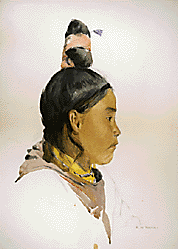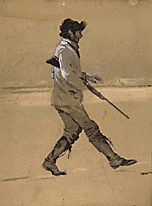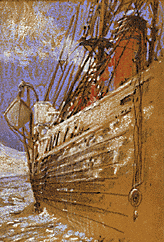The Arctic Sketches of Russell W. Porter
By Mary C. Ryan

|
"Eskimo Girl" A watercolor by Russell Williams Porter, done at Umanak, Greenland, 1896. (NARA, Papers of Russell W. Porter, 1893-1949 [XRWP]) |
One of the most exciting aspects of historical research is coming face to face with tangible evidence of past lives. Though sitting in a research room, one is transported to a different time and place, sharing the excitement, hardships, and hopes of journeys long past. Such an experience occurs in the study of the papers of Russell Williams Porter (1871-1949), one of several turn-of-the-century explorers who ventured into the alien regions above the Arctic Circle in a quest to reach the North Pole. Porter made the trip six times between 1894 and 1903 and left an impressive collection of paintings, drawings, notebooks, journals, and correspondence. One can appreciate Porter's sketches and paintings on many levels: as skillful and beautiful representations of the peoples and lands of the North; as documentation of episodes from the journeys; and, when one realizes that many of the sketches were drawn in subzero temperatures, as testament to the stamina of the expedition members. The Papers of Russell Williams Porter, 1893-1949, are found among the National Archives Collection of Donated Materials.
From 1968 to 1982, collections of federal records and private papers relating to U.S. activity in the polar regions were grouped in the Center for Polar Archives in the National Archives. Today the donated materials are preserved in the Archives II Textual Reference Branch in College Park, Maryland. Approximately 140 collections document Arctic and Antarctic explorations from the late nineteenth century through the 1960s. They contain correspondence, notebooks, diaries, scientific reports, photographs, newspaper clippings and other printed material, charts and maps, sound recordings, films, drawings, paintings, and artifacts.

|
Over the course of six Arctic expeditions, Russell Porter sketched his fellow explorers and recorded daily life in camp. (NARA, Papers of Russell W. Porter, 1893-1949 [XRWP]) |
Russell Porter's papers were donated to the National Archives and Records Service in 1974 by his daughter, Caroline Porter Kier. This portfolio features only a few of the sketches and watercolors in the collection. In addition to the many artworks, the Porter Papers contain diaries, correspondence, notebooks, photographs, and memorabilia. There is also a manuscript and typescript, with ninety-four pencil drawings, of his memoir, "Arctic Fever," which was published in 1976 under the title The Arctic Diary of Russell Williams Porter.
The title Porter gave his memoir aptly describes how intensely he felt the lure of the North. In his introduction he reflected, "there are plenty of fellows, perhaps to their sorrow, who well know the insidious disease, who enter the great white spaces year after year, only to return to civilization beaten and discouraged. . . . The call, in my own case, came suddenly, kept on calling for twelve years, and then as suddenly ceased. . . . My arctic goddess has given me many thrills, many heartbreaks, many crushing defeats, few favors."(1)

|
The America, October 25, 1901. (NARA, Papers of Russell W. Porter, 1893-1949 [XRWP]) |
The sudden call came to him one evening in the fall of 1892. While an architecture student at the Massachusetts Institute of Technology (MIT), Porter attended a lecture by famed Arctic explorer Robert E. Peary and was captivated: "I could see nothing but the pictures Peary threw upon the screen."(2) He immediately contacted Peary, but the explorer turned him down after receiving a letter from Mrs. Porter imploring him not to take her son to the Arctic. Porter soon got a second chance, though, in 1894. That summer he joined an excursion led by Frederick Cook to Greenland and crossed the Arctic Circle for the first time. Although the trip was cut short when the steamer Miranda had to be abandoned, Porter knew he would be back: "Those fugitive glimpses of the shimmering ice cap far back in the interior of that continental island, that week with the natives when the door to the North was barely opened before it was closed, the haunting melodies of the Eskimos accompanied by scuffing feet over a sand floor, the nights without darkness all served only to raise the fever to a higher pitch and a stronger determination to go farther and to see more."(3)
Arctic Sketches of Russell W. Porter, Part 2
Arctic Sketches of Russell W. Porter, Part 3
Arctic Sketches of Russell W. Porter, Part 4
| Articles published in Prologue do not necessarily represent the views of NARA or of any other agency of the United States Government. |